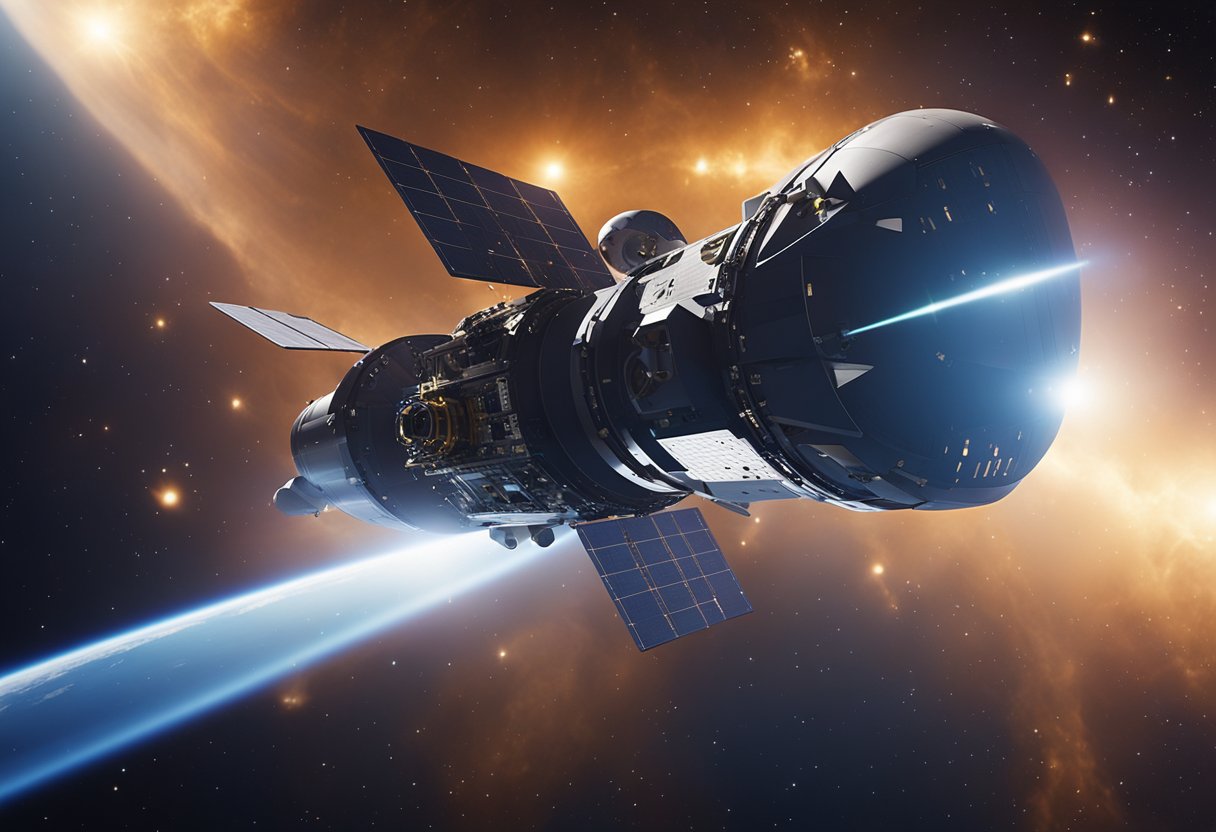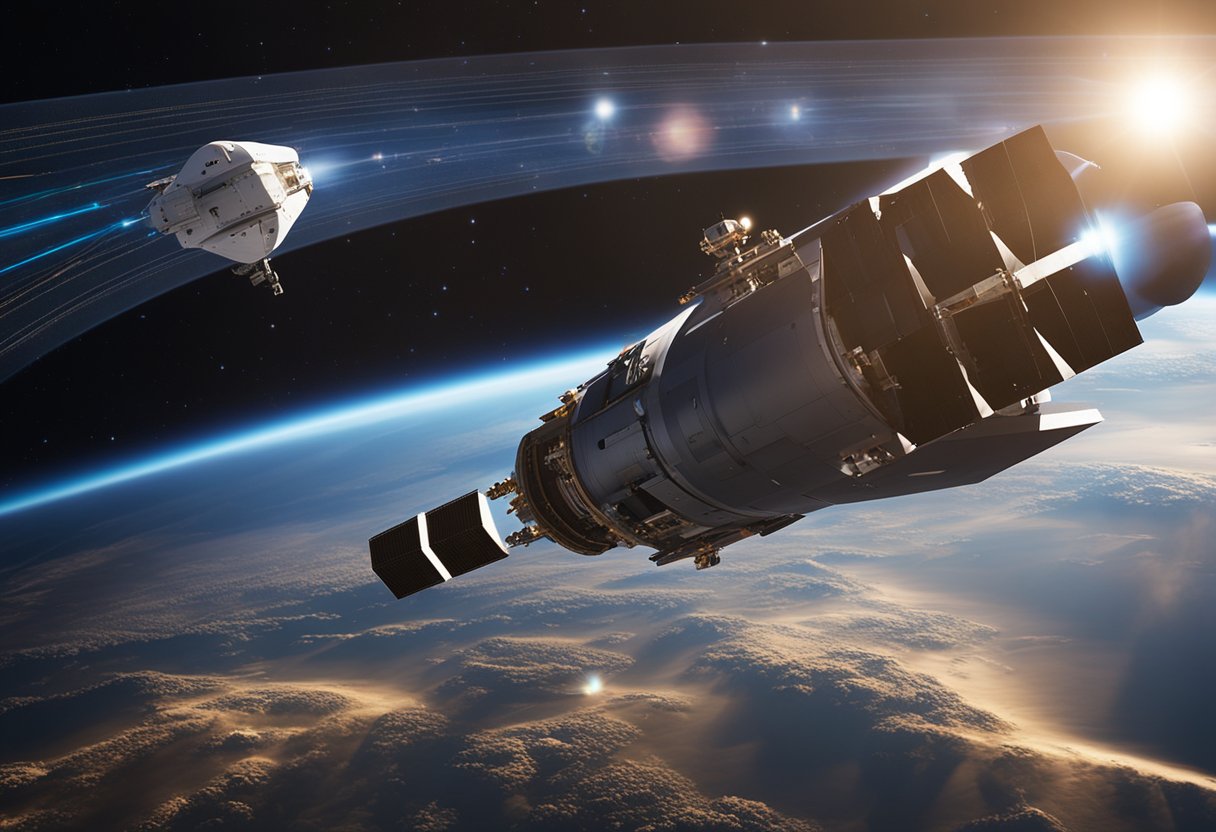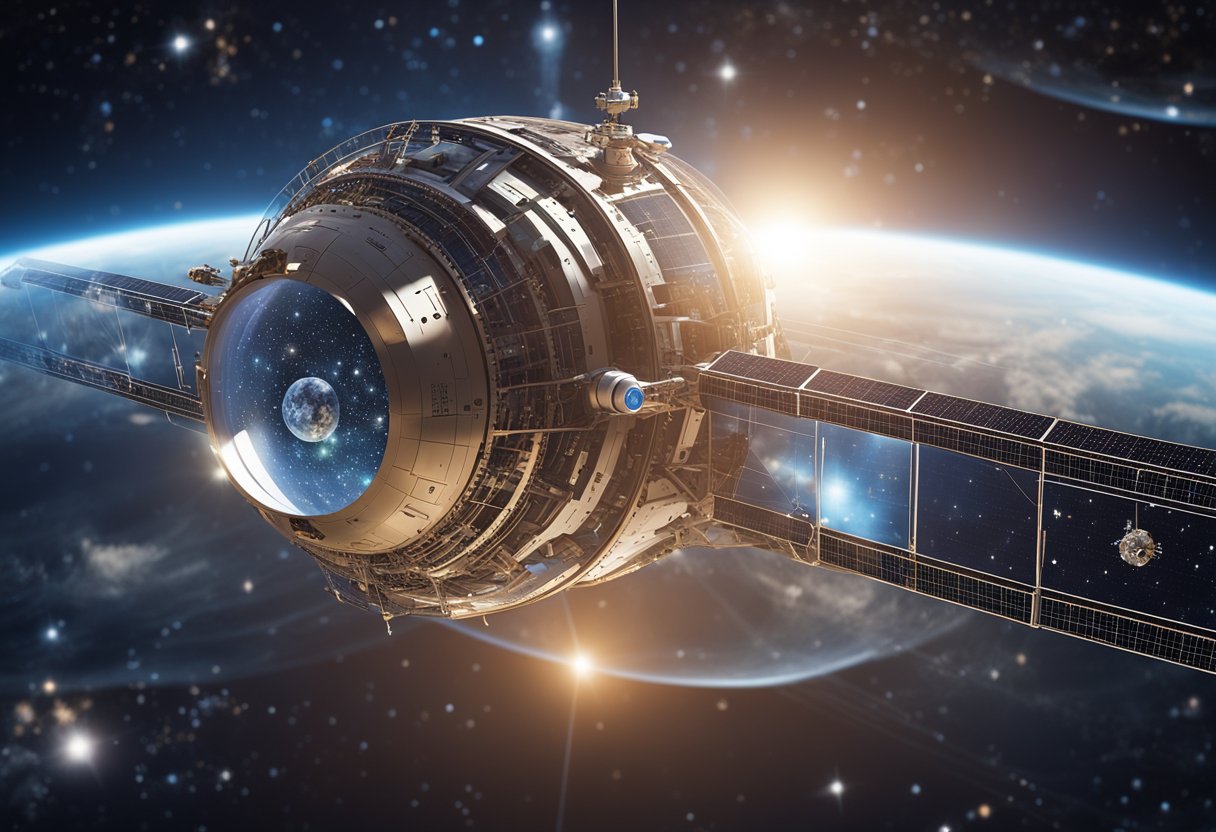
In the pursuit of furthering our reach into the cosmos, laser-based space propulsion has emerged as a promising avenue for propelling spacecraft beyond our atmosphere and potentially to the far reaches of our solar system and beyond. The basic premise of laser propulsion involves the use of light to accelerate a vehicle through space, offering a potentially efficient and propellant-less method of travel. This technology may enable more frequent and cost-effective space missions, making it a focal point of contemporary aerospace research and a likely game-changer in how we approach space exploration.

Laser propulsion technologies span from laser sails, which harness the momentum of photons to push a spacecraft, to laser thermal propulsion, where lasers heat a propellant to produce thrust. These concepts, while still under intensive development, promise to significantly cut travel time within our solar system, thus opening up new possibilities for deep space exploration. The advent of such technologies also aligns with our increasing ability to conduct precision manufacturing and control at the microscopic level, beneficial not only for space tourism but also for scientific and commercial interests in space.
In exploring the fundamentals of laser propulsion, we’re discussing a technology that offers a significant contrast to traditional rocketry, with the potential to revolutionise space travel by directly impacting thrust, specific impulse, and the reliance on reaction mass.
Laser propulsion operates on the principle of using a focussed beam of light to impart momentum to a craft. The technology generates thrust without requiring on-board reaction mass, as the propulsion energy is delivered remotely. In essence, a ground-based laser directs a concentrated beam of radiation onto a spacecraft. This energy is absorbed by a part of the spacecraft designed to create propellant from light, such as a reactant or specialised surface that releases particles when heated, generating thrust.
The specific impulse of a laser propulsion system, a measure of efficiency in terms of impulse per unit of propellant mass, can be significantly higher than that of conventional chemical systems since the reaction mass is not limited by what the spacecraft can carry. Instead, it relies on the power density of the laser and the design of the craft’s propulsion capture and conversion systems.
Conventional propulsion systems carry both fuel and oxidiser on-board, which react to create thrust. This method, while tried-and-tested, has limitations in terms of specific impulse due to the mass of reaction mass that must be carried into space, impacting the payload capacity and mission duration.
In contrast, laser-based systems offer a method where the spacecraft does not need to carry all of its propellant, thereby potentially increasing payload efficiency and reducing the craft’s total mass. The power projected onto the spacecraft from Earth-based or orbital lasers translates into thrust, relying on radiation pressure and the momentum of light to propel the craft.
This type of system, documented by entities like SpaceVoyageVentures.com, emphasises a future where space tourism may benefit from more efficient propulsion methods, extending the reach of potential destinations and potentially reducing costs. Our team continually monitors the progression of such technologies to keep our insights current and relevant.
In the realm of space propulsion, laser technologies present innovative methods for accelerating spacecraft. Each approach utilises lasers distinctively to create thrust, transforming how we envisage propulsion beyond traditional chemical rockets.
Laser ablation propulsion involves targeting a spacecraft’s surface or specially designed material with a laser array. The intense energy from the laser vaporises the material, producing a high-velocity jet of plasma. This reaction generates propulsion through Newton’s third law — for every action, there is an equal and opposite reaction. Laser ablation is particularly useful for small satellite manoeuvres and offers a method of propulsion without the need for onboard propellant.
Electric propulsion systems, such as nuclear-electric propulsion, often use a heating chamber where propellant is ionised and then accelerated to create thrust. Incorporating lasers into electric propulsion, lasers could supply the energy required for the ionisation process.
In contrast, laser-thermal propulsion heats a propellant within a chamber using radiation from a distant laser array. As the propellant heats and expands, it is expelled to produce thrust. This method allows a spacecraft to carry less fuel and rely on external power sources, thus potentially extending mission durations and reducing costs.
In exploring the laser sail concepts, we detail the design intricacies of lightsails, examine the integration of solar sails, and consider the implications of multi-bounce laser-based sails for solar system exploration.
Our design of a lightsail involves an ultrathin, highly reflective material capable of capturing photon momentum from solar or laser sources. The key challenge lies in crafting the sail to withstand radiation and the harsh conditions of space while maintaining a minimal mass to capitalise on the photons’ thrust. The materials we select often edge towards thin metallic films or durable polymer-based substances that reflect light effectively.
Solar sails harness the sun’s photons for propulsion and become even more effective when integrated with laser technology. By augmenting the solar thrust with focused beams of light from high power lasers, we enhance the solar sail‘s acceleration dramatically. This synergy allows sails to reach velocities that make significant exploration within our lifetime feasible, as indicated by the concepts of miniature laser-pushed lightsails for solar system travel.
Our approach to multi-bounce laser-based sails revolves around maximising the momentum transfer from a single photon by allowing it to reflect multiple times within the sail system. The principle of a multi-bounce laser-based sail is to create a set-up where photons ‘bounce’ between reflective surfaces, compounding their propulsive effect. By iterating this design, we aim to create less wasteful, more efficient laser-pushed lightsails that could open up pathways for agile manoeuvring in Earth’s orbit and beyond. The study of low-power laser sailing for rapid transit space flight demonstrates these principles with promises of augmented speeds and reduced transit times.
Within the realm of space propulsion, leveraging lasers is yielding remarkable innovations. We’ll explore the essentials of phased-array lasers, fibre-optic lasers, and adaptive optics – each significant for our endeavours in space travel.
Phased-array lasers represent a leap forward in precision and power for space propulsion. By coherently combining beams from a multitude of emitters, we obtain a finely controllable output. This powerful unison can propel spacecraft at unprecedented velocities, as detailed in studies anticipating arrays with diameters of several metres and power outputs in the order of 100 megawatts. These arrays, significant for their abilities to compensate for atmospheric distortions, could effectively deliver energy to spacecraft in near-Earth space.
Fibre-optic lasers use optical fibres doped with rare-earth elements like erbium or neodymium to amplify light. The strength of these lasers lies in their high beam quality and efficiency, coupled with the flexibility of the fibre’s routing. Their development has been driven by advancements that have seen considerable gains in power output, making them a coveted choice for laser propulsion applications.
Adaptive optics is a technology integral to correcting distortions introduced by the Earth’s atmosphere, vital for ground-based laser propulsion systems. Utilising deformable mirrors controlled by computer algorithms, we can adjust the laser beam in real-time. This correction ensures the laser maintains the energy density required to effectively propel a spacecraft after transmission through the turbulent atmosphere.
Our exploration of these technologies indicates an exhilarating prospect for the use of lasers in space propulsion, each system offering unique benefits that could be pivotal in propelling the visions of companies, such as the budding SpaceVoyageVentures.com, into reality. As we harness and refine these sophisticated laser systems, our pathways across the solar system become ever more tangible.
Laser propulsion has emerged as a promising technology for revolutionising space travel, offering potentially quicker and more cost-effective methods of sending payloads and even humans into space.

The Breakthrough Starshot Project represents a bold initiative aimed at developing spacecraft capable of making interstellar voyages. Utilising light sails propelled by powerful ground-based lasers, these crafts could theoretically reach the Alpha Centauri star system, our nearest neighbour, in around 20 years. We’ve designed these diminutive yet sturdy laser-propelled vessels to carry minuscule payloads, a daring plan to make humanity’s first leap into deep space exploration.
Our team closely follows NASA’s breakthroughs in the domain of in-space propulsion. NASA’s contributions are pivotal in the advancement of these technologies, striving for greater propulsive capabilities for small spacecraft. This encompasses state-of-the-art laser propulsion which, despite its nascent stage, holds potential for revolutionising how we undertake space missions, especially in terms of efficiency and cost reduction.
As we forecast the future of space exploration, the integration of laser propulsion in crewed missions remains high on our agenda. While this concept is still largely theoretical, the idea of sending astronauts into orbit or even to other celestial bodies using laser propulsion systems is gaining momentum. The potential for a propulsion system that is both throttleable and highly efficient paves the way for a new paradigm in human spaceflight.
We anticipate that the continued development in this field will not only cater to the requirements of rigorous scientific space missions but also kindle the interest of the space tourism industry, as documented by platforms like SpaceVoyageVentures.com. Our vision includes the potential for laser-propelled trips that could transform the accessibility of space, making it a tangible reality for future tourists.

The advent of laser-based space propulsion represents a transformative leap in our capabilities to explore the cosmos. It furnishes us with the potential for reaching unprecedented speeds, reducing travel times to alien worlds, and even holding the promise of pushing boundaries towards interstellar travel.
Laser propulsion systems could revolutionise our approach to interstellar flight. By utilising powerful lasers to accelerate spacecraft to a fraction of the speed of light, we may one day send probes to neighbouring star systems. For instance, projects like the Breakthrough Starshot initiative aim to develop spacecraft capable of making the journey to Alpha Centauri, the closest star system to us.
With enhanced velocity, spacecraft equipped with laser-based systems can manoeuvre within the solar system more efficiently. Such technology boosts the crafts’ speed far beyond traditional chemical rockets, which translates to shorter mission durations and extended operational lifespans for space probes and satellites.
One of the most exciting prospects of laser propulsion is the possibility of rapid transit to Mars. It’s conceivable that future missions to the Red Planet could take weeks instead of months, a monumental stride that aligns with our vision at SpaceVoyageVentures.com for accessible interplanetary travel. This advancement not only enhances the viability of manned missions but also supports a sustained human presence on Mars.
As we explore the frontier of space travel, we recognise that laser-based space propulsion, while promising, presents specific challenges and limitations that must be addressed.
We must acknowledge the technological challenges that currently impede the widespread adoption of laser space propulsion. For example, we need lasers that can deliver high levels of power consistently over vast distances in space. Ensuring a precise alignment of these powerful laser beams with the spacecraft over those distances is also a significant technical hurdle. The breadth of these challenges is outlined in an article discussing the physical mechanisms for photonic space propulsion.
The materials used in constructing laser-propelled spacecraft must withstand repeated exposure to intense laser pulses without degrading. As one report elaborates, the dual concerns of thermal coupling and mechanical stress from repetitive pulses could melt the target or otherwise damage it, severely limiting the lifespan of the propulsion system. Our focus must be on developing materials and processing methods that optimise durability.
Finally, optimising the performance of photovoltaic arrays is paramount. These arrays need to efficiently convert incident laser light into electrical energy, but their effectiveness diminishes with distance as the laser beam diverges. It’s critical to ensure that arrays are not only powerful but also scalable and reliable over long-duration missions. The utility and potential risks associated with laser use in space, including the operational limits of photovoltaic arrays, are scrutinised in Potential, Risks, and Mitigation Strategies.

In the development of laser-based space propulsion, we have to give considerable thought to the types of fuel and propellants we use, as they are the key to optimising performance and efficiency. Our discussions will cover not just traditional hydrogen propellants, but also how we can leverage solar energy and the strategies we have developed to reduce reaction mass.
Hydrogen is a widely embraced propellant within our solar system’s context due to its high specific impulse capabilities. We use hydrogen because it provides an efficient reaction when combined with oxygen, producing a desirable thrust-to-weight ratio. Factoring in the benefits of laser-accelerated plasma-propulsion systems, we can enhance the efficacy of hydrogen as a propellant, making it even more conducive to deep space exploration.
Our venture into space propulsion isn’t limited to chemical reactions. We leverage solar energy, a virtually inexhaustible energy source, to augment our propulsion systems. Through the integration of technologies such as solar sails, we effectively use solar photons’ momentum, which, while providing lower thrust levels, is persistent and can accumulate significant speeds over time.
To optimise our operations, we constantly strive to reduce reaction mass. This is the mass that our spacecraft carry and eventually expel in the form of propellant to produce thrust. Through the innovation of propellantless propulsion techniques, such as those using hybrid rocket technology, we are making steady progress in reducing the amount of reaction mass required. This reduction directly translates into increased payload capacity or extended mission durations, opening up new horizons for both exploration and potential future space tourism as detailed on SpaceVoyageVentures.com.
In the context of space exploration, our ability to control and communicate with spacecraft has taken a significant leap forward due to the integration of laser-based systems. These advancements not only improve the quality and speed of data transmission but also enhance the autonomy of navigation in space.
Laser communications, known as optical communications when referred to in the context of space, represent a transformative shift from traditional radio frequency (RF) systems. Our efforts have realised systems that dramatically increase bandwidth, enabling high-definition video transmissions and vast data streams from spacecraft to Earth. This technology has been validated with initiatives like the LCRD — the Laser Communications Relay Demonstration — that NASA’s laser communications advancements continue with experiments that refine laser communications for future applicability.
Our capacity to transfer data has witnessed an exponential increase with laser comms. NASA’s achievement of a 200 gigabit per second data rate is a testament to this, creating the fastest space-to-ground laser comms link ever. This record-breaking speed underpins the potential of laser comms to support the growing data needs of various missions and the burgeoning space tourism sector as outlined by SpaceVoyageVentures.com.
The precision of laser communications offers us the potential for enhanced autonomous navigation of spacecraft. By providing accurate, real-time data, spacecraft can make adjustments with minimal delay, improving navigational efficiency and safety. This has profound implications for the management of unmanned missions, especially in deep space, where traditional communication methods face significant delays.
Advancements in control and communication via laser systems are a pivotal milestone in our journey to expand human presence in space. These technologies not only support our current endeavours but also lay the groundwork for future exploration and commercial ventures beyond Earth’s orbit.

In this section, we explore the cutting-edge advancements in laser-based space propulsion and envisage the transformative impact these technologies may have on space exploration.
Recent advancements have made photonic propulsion a fast-evolving field. Arthur Kantrowitz first proposed the idea in 1972, and since then, significant milestones have been achieved, including the deployment of the first microlaser propulsion system on the KKS-1 microsatellite. The core principle involves using directed energy to propel crafts without the need for on-board propellant. This method promises to drastically reduce mass and increase the potential distances that can be travelled in space.
As we push the boundaries of current technology, new propulsion methods such as Directed Energy Propulsion (DEP) are on the horizon. DEP utilises “lightsails” that are accelerated to a fraction of the speed of light by lasers, potentially enabling unprecedented exploration of distant star systems. This concept is not only a theoretical possibility; initial experiments and research are redefining what we consider achievable within the next few decades of space travel.
The ambition to revolutionise space travel through laser propulsion is not confined to any single nation or agency. It’s a global venture that requires collaboration and shared knowledge. International projects and partnerships aim to leverage the expertise and resources of various countries and organisations. Such cooperation is essential for undertaking the colossal engineering challenges associated with developing and deploying advanced laser propulsion systems.
We explore some of the most common inquiries about laser-based propulsion, addressing how it works, its benefits, potential speeds, and the latest advancements.
Laser propulsion operates by harnessing the momentum of photons to exert force on a spacecraft. The photons bounce off of the spacecraft’s sails, prompting movement without the need for conventional fuel. This technique is similar to the force exerted by solar sails but leverages laser beams for a more concentrated push.
Ablative laser propulsion offers the significant benefit of not having to carry the reaction mass on board the spacecraft, as the propellant material can be provided externally by the laser system. This results in a lighter spacecraft and the potential for high speeds with proper energy efficiency.
Lasers can propel spacecraft by either using the beam to push the craft directly through radiation pressure or by heating a propellant to produce thrust, much like in traditional rockets. These methods provide a versatile means of propelling spacecraft without relying on internal fuel.
The field of laser propulsion has seen numerous technological advancements, including proposals for large-scale laser arrays that could potentially push spacecraft to significant velocities. Ideas like the construction of an array the size of Manhattan illustrate the ambitious nature of these advancements and the future potential.
Spacecraft using laser-based propulsion are theorised to be capable of reaching tremendous speeds, potentially much faster than any current propulsion system. This could markedly shorten interstellar travel times and allow us to venture further into space.
Photonic propulsion is still primarily at the experimental and theoretical stages. However, it is considered a promising option for manoeuvring in space due to its reliance on light, the ubiquitous energy resource in our universe, and its ability to function without ejecting mass. The technology’s practicality will depend on future advancements and successful demonstrations of its efficacy.